Level 3 Diploma: Health and Social Care Introduction Report Analysis
VerifiedAdded on 2022/12/27
|7
|1392
|44
Report
AI Summary
This report provides an introduction to Health and Social Care, addressing key aspects of the field. It begins by outlining ways health and social care professionals protect individuals, including providing a safe environment, offering psychological support, and partnering with service providers. It then explores mechanisms for reporting poor practices and the roles of regulatory bodies like the Care Quality Commission (CQC) and the NHS in inspecting health and social care provision. The report further examines professional bodies such as the General Medical Council (GMC) and their roles in regulating professions. It details the roles and responsibilities of inter-professional teams, differentiating between multidisciplinary and inter-professional team working, and identifying potential barriers to team working, along with solutions. The report is well-structured, providing a comprehensive overview of the core concepts in health and social care, supported by references to relevant literature.
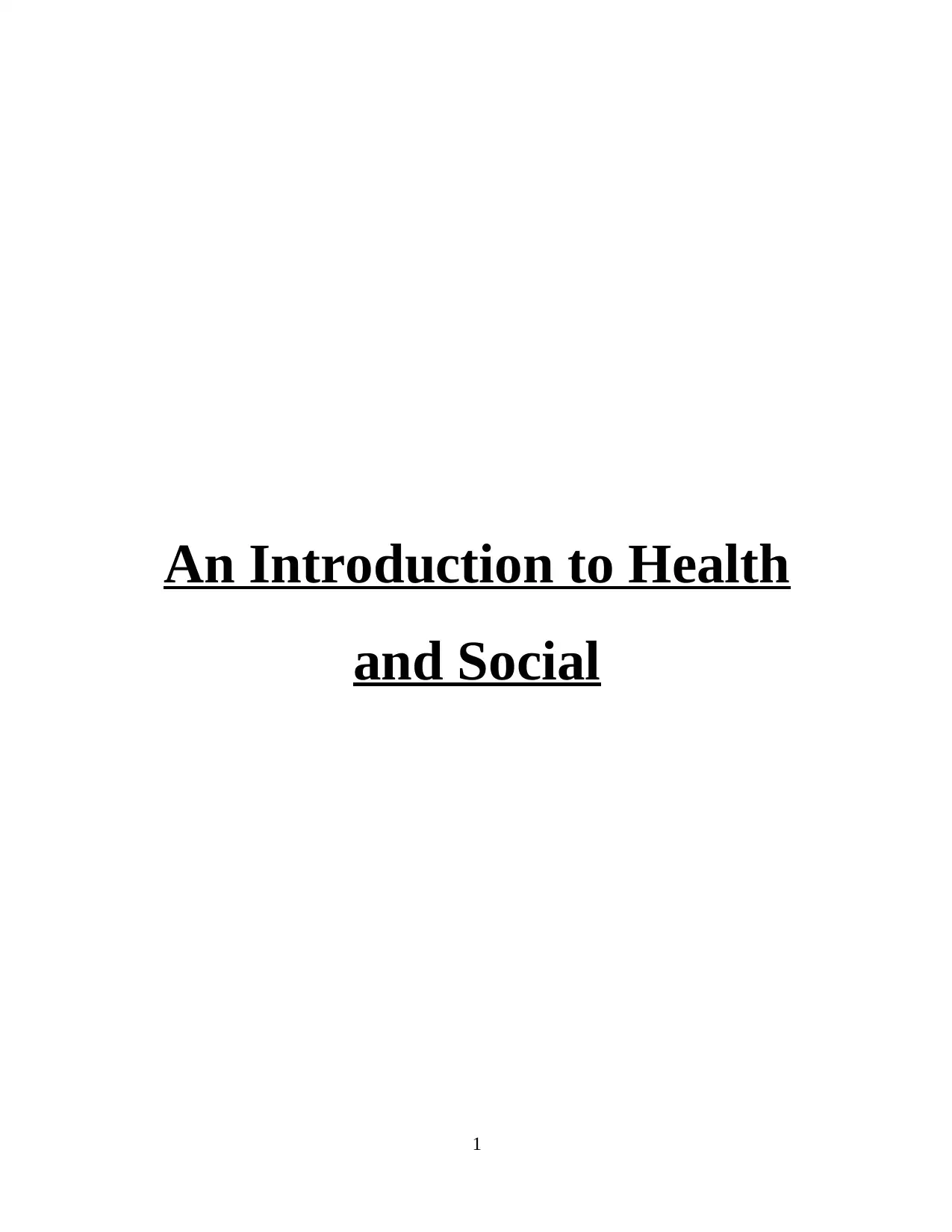
An Introduction to Health
and Social
1
and Social
1
Paraphrase This Document
Need a fresh take? Get an instant paraphrase of this document with our AI Paraphraser
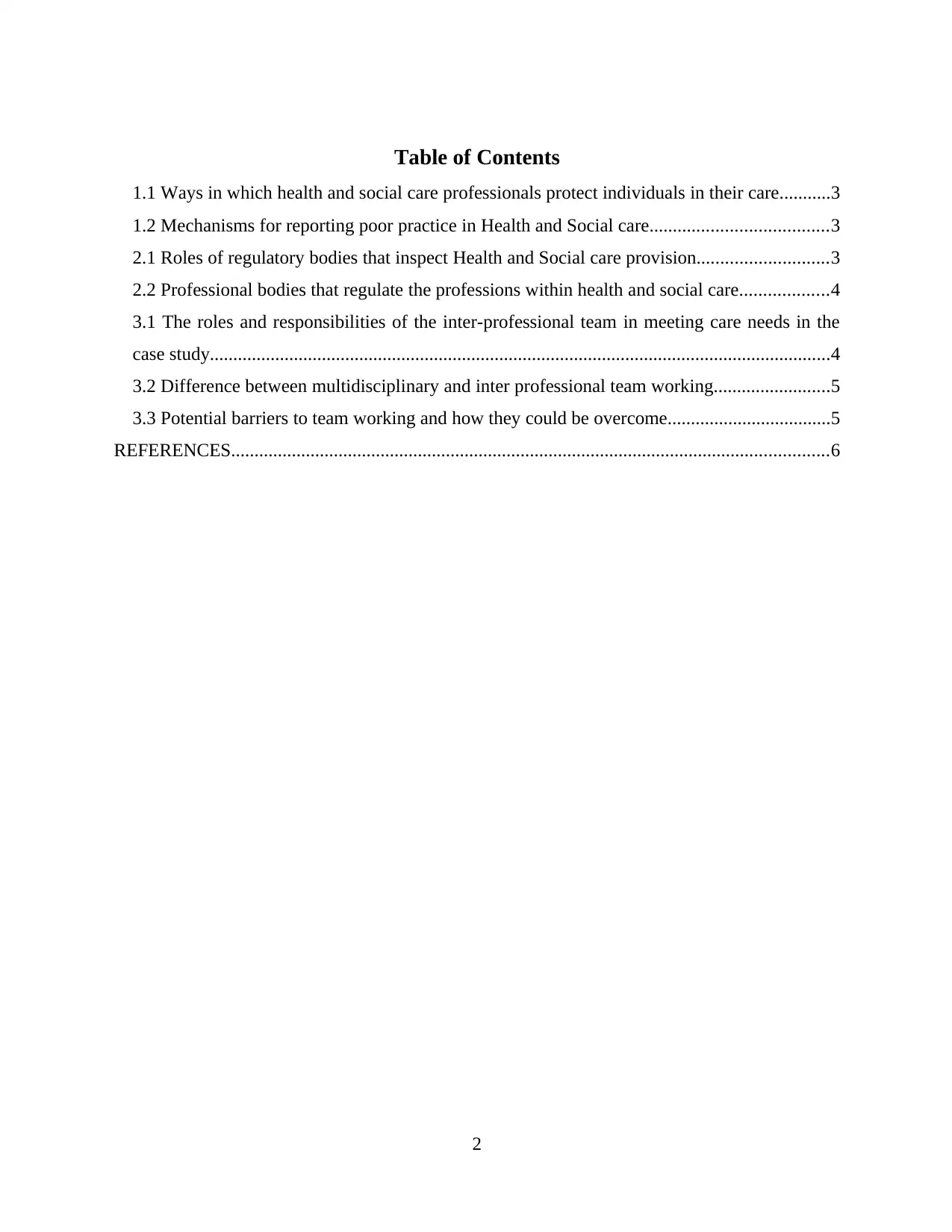
Table of Contents
1.1 Ways in which health and social care professionals protect individuals in their care...........3
1.2 Mechanisms for reporting poor practice in Health and Social care......................................3
2.1 Roles of regulatory bodies that inspect Health and Social care provision............................3
2.2 Professional bodies that regulate the professions within health and social care...................4
3.1 The roles and responsibilities of the inter-professional team in meeting care needs in the
case study.....................................................................................................................................4
3.2 Difference between multidisciplinary and inter professional team working.........................5
3.3 Potential barriers to team working and how they could be overcome...................................5
REFERENCES................................................................................................................................6
2
1.1 Ways in which health and social care professionals protect individuals in their care...........3
1.2 Mechanisms for reporting poor practice in Health and Social care......................................3
2.1 Roles of regulatory bodies that inspect Health and Social care provision............................3
2.2 Professional bodies that regulate the professions within health and social care...................4
3.1 The roles and responsibilities of the inter-professional team in meeting care needs in the
case study.....................................................................................................................................4
3.2 Difference between multidisciplinary and inter professional team working.........................5
3.3 Potential barriers to team working and how they could be overcome...................................5
REFERENCES................................................................................................................................6
2
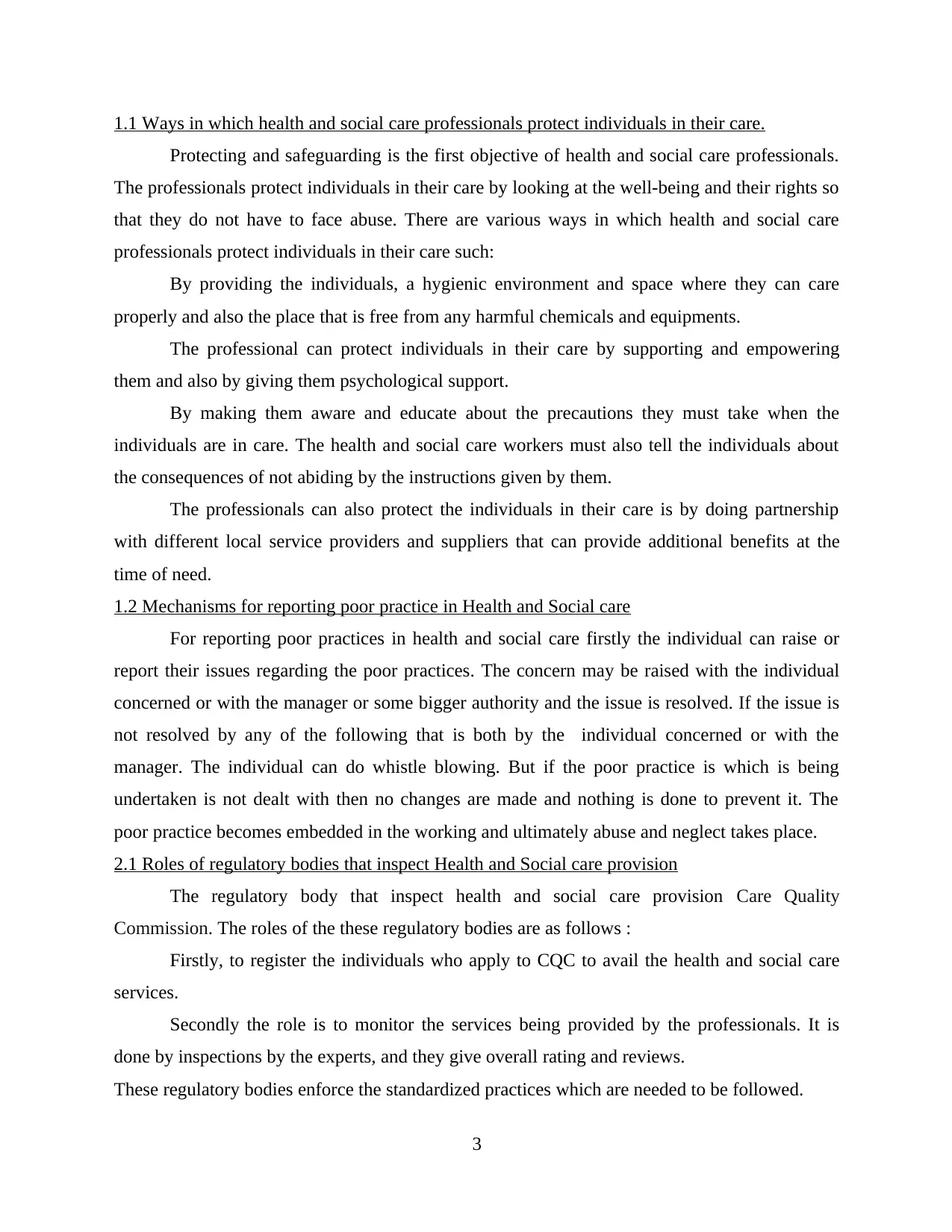
1.1 Ways in which health and social care professionals protect individuals in their care.
Protecting and safeguarding is the first objective of health and social care professionals.
The professionals protect individuals in their care by looking at the well-being and their rights so
that they do not have to face abuse. There are various ways in which health and social care
professionals protect individuals in their care such:
By providing the individuals, a hygienic environment and space where they can care
properly and also the place that is free from any harmful chemicals and equipments.
The professional can protect individuals in their care by supporting and empowering
them and also by giving them psychological support.
By making them aware and educate about the precautions they must take when the
individuals are in care. The health and social care workers must also tell the individuals about
the consequences of not abiding by the instructions given by them.
The professionals can also protect the individuals in their care is by doing partnership
with different local service providers and suppliers that can provide additional benefits at the
time of need.
1.2 Mechanisms for reporting poor practice in Health and Social care
For reporting poor practices in health and social care firstly the individual can raise or
report their issues regarding the poor practices. The concern may be raised with the individual
concerned or with the manager or some bigger authority and the issue is resolved. If the issue is
not resolved by any of the following that is both by the individual concerned or with the
manager. The individual can do whistle blowing. But if the poor practice is which is being
undertaken is not dealt with then no changes are made and nothing is done to prevent it. The
poor practice becomes embedded in the working and ultimately abuse and neglect takes place.
2.1 Roles of regulatory bodies that inspect Health and Social care provision
The regulatory body that inspect health and social care provision Care Quality
Commission. The roles of the these regulatory bodies are as follows :
Firstly, to register the individuals who apply to CQC to avail the health and social care
services.
Secondly the role is to monitor the services being provided by the professionals. It is
done by inspections by the experts, and they give overall rating and reviews.
These regulatory bodies enforce the standardized practices which are needed to be followed.
3
Protecting and safeguarding is the first objective of health and social care professionals.
The professionals protect individuals in their care by looking at the well-being and their rights so
that they do not have to face abuse. There are various ways in which health and social care
professionals protect individuals in their care such:
By providing the individuals, a hygienic environment and space where they can care
properly and also the place that is free from any harmful chemicals and equipments.
The professional can protect individuals in their care by supporting and empowering
them and also by giving them psychological support.
By making them aware and educate about the precautions they must take when the
individuals are in care. The health and social care workers must also tell the individuals about
the consequences of not abiding by the instructions given by them.
The professionals can also protect the individuals in their care is by doing partnership
with different local service providers and suppliers that can provide additional benefits at the
time of need.
1.2 Mechanisms for reporting poor practice in Health and Social care
For reporting poor practices in health and social care firstly the individual can raise or
report their issues regarding the poor practices. The concern may be raised with the individual
concerned or with the manager or some bigger authority and the issue is resolved. If the issue is
not resolved by any of the following that is both by the individual concerned or with the
manager. The individual can do whistle blowing. But if the poor practice is which is being
undertaken is not dealt with then no changes are made and nothing is done to prevent it. The
poor practice becomes embedded in the working and ultimately abuse and neglect takes place.
2.1 Roles of regulatory bodies that inspect Health and Social care provision
The regulatory body that inspect health and social care provision Care Quality
Commission. The roles of the these regulatory bodies are as follows :
Firstly, to register the individuals who apply to CQC to avail the health and social care
services.
Secondly the role is to monitor the services being provided by the professionals. It is
done by inspections by the experts, and they give overall rating and reviews.
These regulatory bodies enforce the standardized practices which are needed to be followed.
3
⊘ This is a preview!⊘
Do you want full access?
Subscribe today to unlock all pages.

Trusted by 1+ million students worldwide
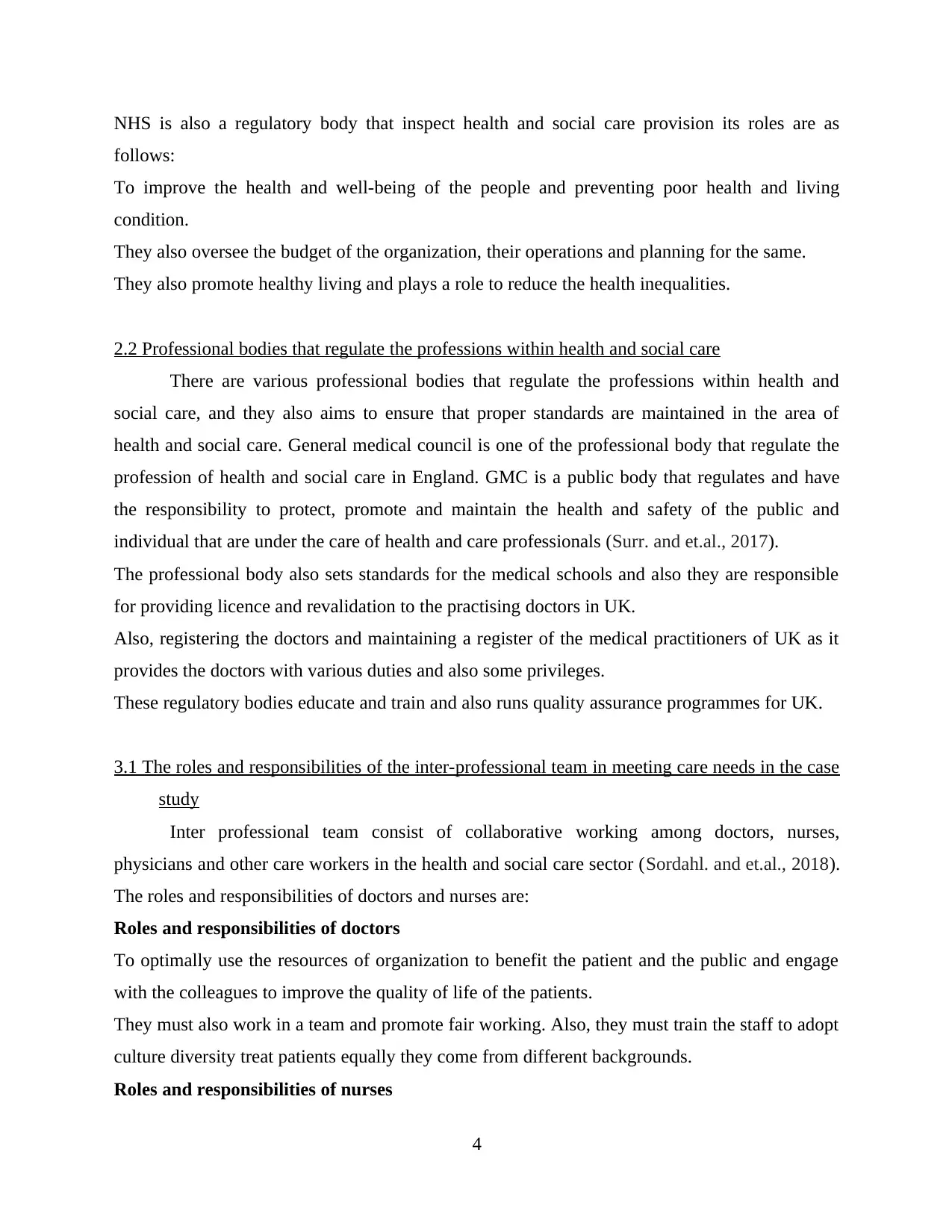
NHS is also a regulatory body that inspect health and social care provision its roles are as
follows:
To improve the health and well-being of the people and preventing poor health and living
condition.
They also oversee the budget of the organization, their operations and planning for the same.
They also promote healthy living and plays a role to reduce the health inequalities.
2.2 Professional bodies that regulate the professions within health and social care
There are various professional bodies that regulate the professions within health and
social care, and they also aims to ensure that proper standards are maintained in the area of
health and social care. General medical council is one of the professional body that regulate the
profession of health and social care in England. GMC is a public body that regulates and have
the responsibility to protect, promote and maintain the health and safety of the public and
individual that are under the care of health and care professionals (Surr. and et.al., 2017).
The professional body also sets standards for the medical schools and also they are responsible
for providing licence and revalidation to the practising doctors in UK.
Also, registering the doctors and maintaining a register of the medical practitioners of UK as it
provides the doctors with various duties and also some privileges.
These regulatory bodies educate and train and also runs quality assurance programmes for UK.
3.1 The roles and responsibilities of the inter-professional team in meeting care needs in the case
study
Inter professional team consist of collaborative working among doctors, nurses,
physicians and other care workers in the health and social care sector (Sordahl. and et.al., 2018).
The roles and responsibilities of doctors and nurses are:
Roles and responsibilities of doctors
To optimally use the resources of organization to benefit the patient and the public and engage
with the colleagues to improve the quality of life of the patients.
They must also work in a team and promote fair working. Also, they must train the staff to adopt
culture diversity treat patients equally they come from different backgrounds.
Roles and responsibilities of nurses
4
follows:
To improve the health and well-being of the people and preventing poor health and living
condition.
They also oversee the budget of the organization, their operations and planning for the same.
They also promote healthy living and plays a role to reduce the health inequalities.
2.2 Professional bodies that regulate the professions within health and social care
There are various professional bodies that regulate the professions within health and
social care, and they also aims to ensure that proper standards are maintained in the area of
health and social care. General medical council is one of the professional body that regulate the
profession of health and social care in England. GMC is a public body that regulates and have
the responsibility to protect, promote and maintain the health and safety of the public and
individual that are under the care of health and care professionals (Surr. and et.al., 2017).
The professional body also sets standards for the medical schools and also they are responsible
for providing licence and revalidation to the practising doctors in UK.
Also, registering the doctors and maintaining a register of the medical practitioners of UK as it
provides the doctors with various duties and also some privileges.
These regulatory bodies educate and train and also runs quality assurance programmes for UK.
3.1 The roles and responsibilities of the inter-professional team in meeting care needs in the case
study
Inter professional team consist of collaborative working among doctors, nurses,
physicians and other care workers in the health and social care sector (Sordahl. and et.al., 2018).
The roles and responsibilities of doctors and nurses are:
Roles and responsibilities of doctors
To optimally use the resources of organization to benefit the patient and the public and engage
with the colleagues to improve the quality of life of the patients.
They must also work in a team and promote fair working. Also, they must train the staff to adopt
culture diversity treat patients equally they come from different backgrounds.
Roles and responsibilities of nurses
4
Paraphrase This Document
Need a fresh take? Get an instant paraphrase of this document with our AI Paraphraser
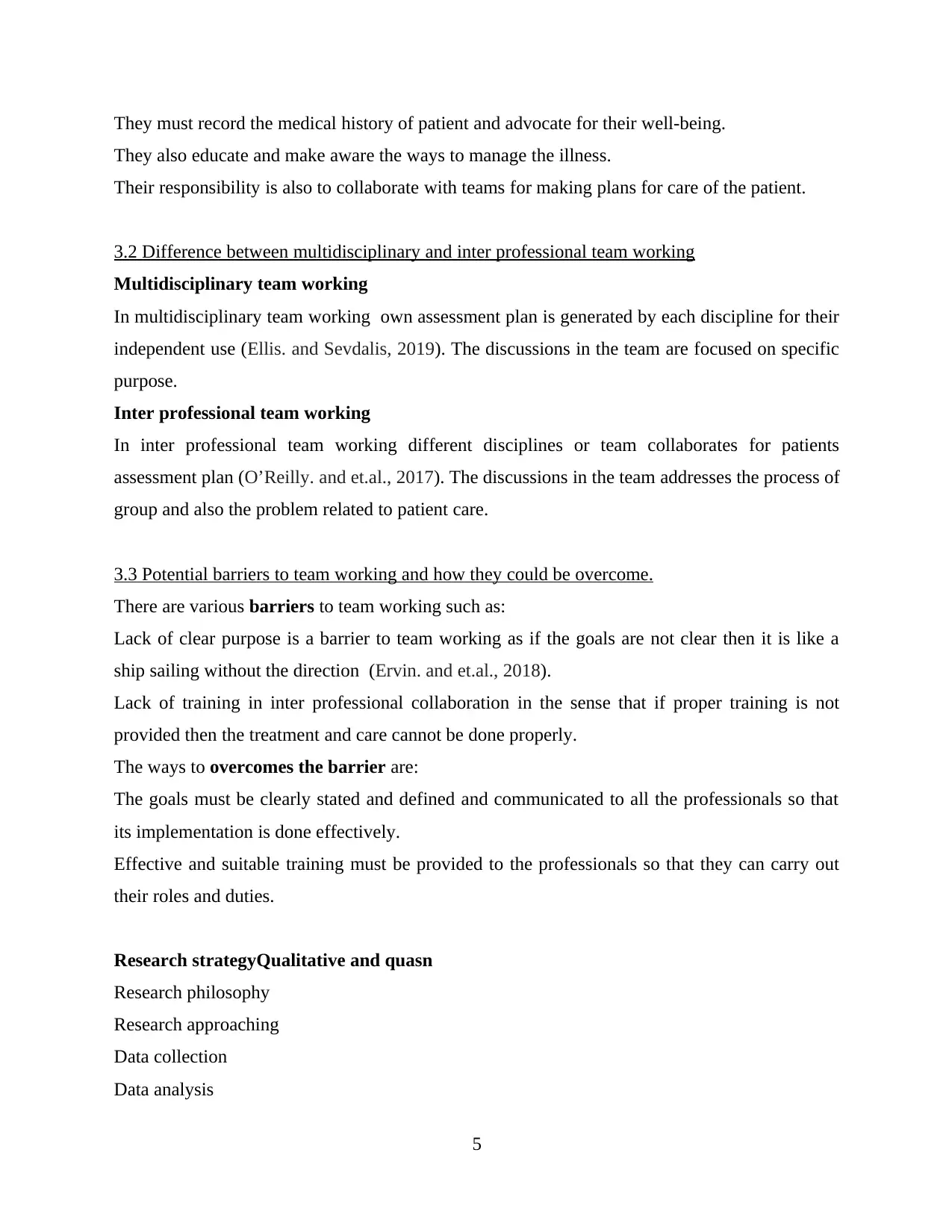
They must record the medical history of patient and advocate for their well-being.
They also educate and make aware the ways to manage the illness.
Their responsibility is also to collaborate with teams for making plans for care of the patient.
3.2 Difference between multidisciplinary and inter professional team working
Multidisciplinary team working
In multidisciplinary team working own assessment plan is generated by each discipline for their
independent use (Ellis. and Sevdalis, 2019). The discussions in the team are focused on specific
purpose.
Inter professional team working
In inter professional team working different disciplines or team collaborates for patients
assessment plan (O’Reilly. and et.al., 2017). The discussions in the team addresses the process of
group and also the problem related to patient care.
3.3 Potential barriers to team working and how they could be overcome.
There are various barriers to team working such as:
Lack of clear purpose is a barrier to team working as if the goals are not clear then it is like a
ship sailing without the direction (Ervin. and et.al., 2018).
Lack of training in inter professional collaboration in the sense that if proper training is not
provided then the treatment and care cannot be done properly.
The ways to overcomes the barrier are:
The goals must be clearly stated and defined and communicated to all the professionals so that
its implementation is done effectively.
Effective and suitable training must be provided to the professionals so that they can carry out
their roles and duties.
Research strategyQualitative and quasn
Research philosophy
Research approaching
Data collection
Data analysis
5
They also educate and make aware the ways to manage the illness.
Their responsibility is also to collaborate with teams for making plans for care of the patient.
3.2 Difference between multidisciplinary and inter professional team working
Multidisciplinary team working
In multidisciplinary team working own assessment plan is generated by each discipline for their
independent use (Ellis. and Sevdalis, 2019). The discussions in the team are focused on specific
purpose.
Inter professional team working
In inter professional team working different disciplines or team collaborates for patients
assessment plan (O’Reilly. and et.al., 2017). The discussions in the team addresses the process of
group and also the problem related to patient care.
3.3 Potential barriers to team working and how they could be overcome.
There are various barriers to team working such as:
Lack of clear purpose is a barrier to team working as if the goals are not clear then it is like a
ship sailing without the direction (Ervin. and et.al., 2018).
Lack of training in inter professional collaboration in the sense that if proper training is not
provided then the treatment and care cannot be done properly.
The ways to overcomes the barrier are:
The goals must be clearly stated and defined and communicated to all the professionals so that
its implementation is done effectively.
Effective and suitable training must be provided to the professionals so that they can carry out
their roles and duties.
Research strategyQualitative and quasn
Research philosophy
Research approaching
Data collection
Data analysis
5
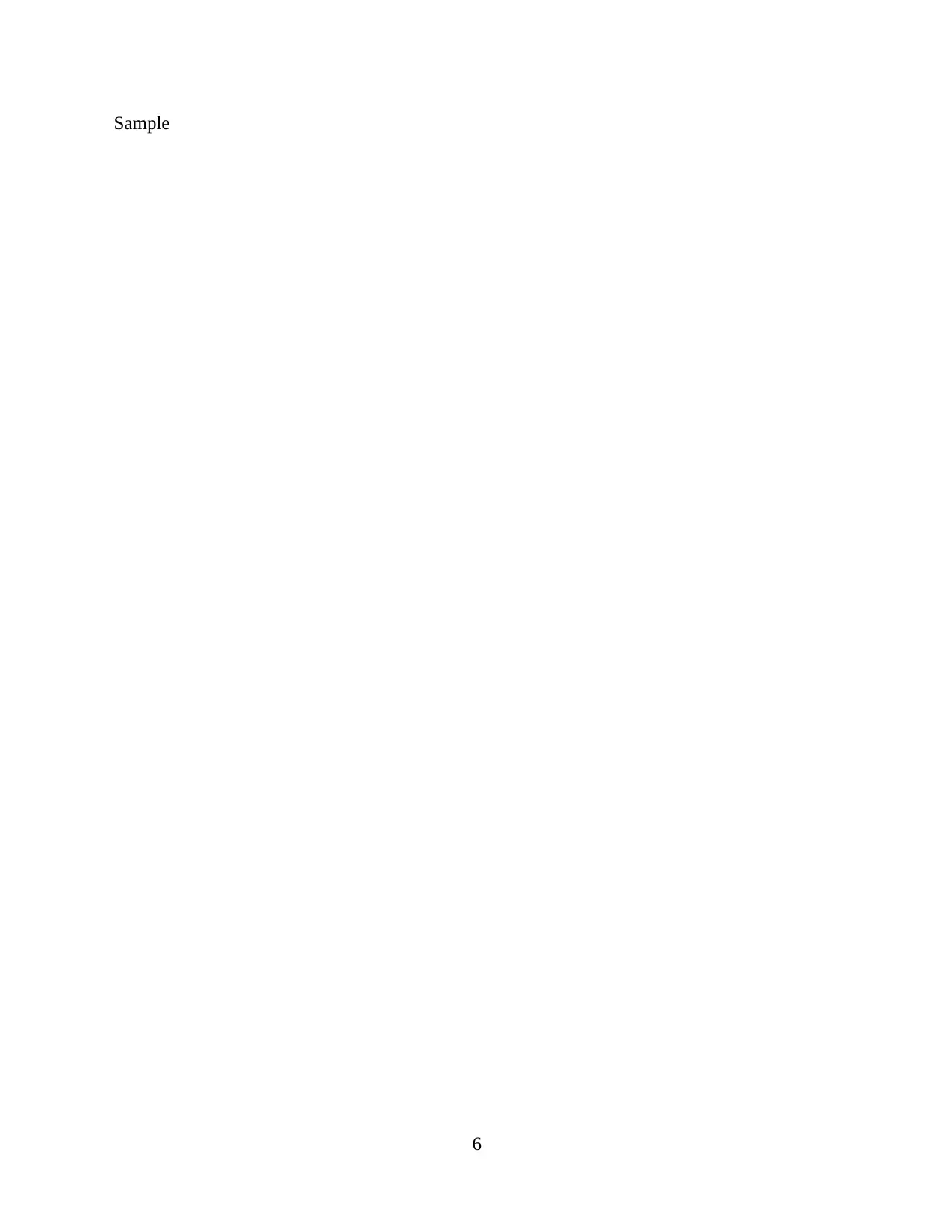
Sample
6
6
⊘ This is a preview!⊘
Do you want full access?
Subscribe today to unlock all pages.

Trusted by 1+ million students worldwide
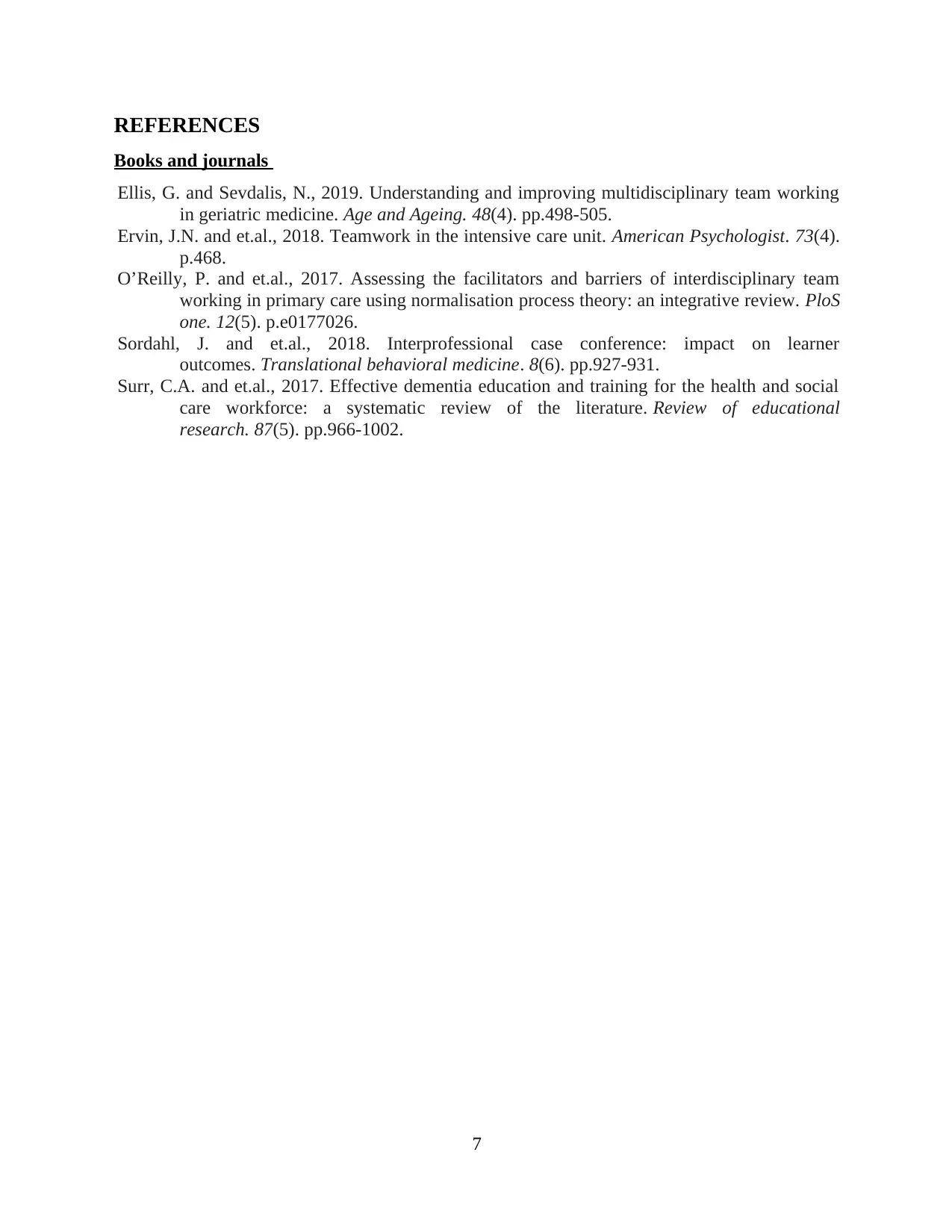
REFERENCES
Books and journals
Ellis, G. and Sevdalis, N., 2019. Understanding and improving multidisciplinary team working
in geriatric medicine. Age and Ageing. 48(4). pp.498-505.
Ervin, J.N. and et.al., 2018. Teamwork in the intensive care unit. American Psychologist. 73(4).
p.468.
O’Reilly, P. and et.al., 2017. Assessing the facilitators and barriers of interdisciplinary team
working in primary care using normalisation process theory: an integrative review. PloS
one. 12(5). p.e0177026.
Sordahl, J. and et.al., 2018. Interprofessional case conference: impact on learner
outcomes. Translational behavioral medicine. 8(6). pp.927-931.
Surr, C.A. and et.al., 2017. Effective dementia education and training for the health and social
care workforce: a systematic review of the literature. Review of educational
research. 87(5). pp.966-1002.
7
Books and journals
Ellis, G. and Sevdalis, N., 2019. Understanding and improving multidisciplinary team working
in geriatric medicine. Age and Ageing. 48(4). pp.498-505.
Ervin, J.N. and et.al., 2018. Teamwork in the intensive care unit. American Psychologist. 73(4).
p.468.
O’Reilly, P. and et.al., 2017. Assessing the facilitators and barriers of interdisciplinary team
working in primary care using normalisation process theory: an integrative review. PloS
one. 12(5). p.e0177026.
Sordahl, J. and et.al., 2018. Interprofessional case conference: impact on learner
outcomes. Translational behavioral medicine. 8(6). pp.927-931.
Surr, C.A. and et.al., 2017. Effective dementia education and training for the health and social
care workforce: a systematic review of the literature. Review of educational
research. 87(5). pp.966-1002.
7
1 out of 7
Related Documents
Your All-in-One AI-Powered Toolkit for Academic Success.
+13062052269
info@desklib.com
Available 24*7 on WhatsApp / Email
![[object Object]](/_next/static/media/star-bottom.7253800d.svg)
Unlock your academic potential
Copyright © 2020–2025 A2Z Services. All Rights Reserved. Developed and managed by ZUCOL.





